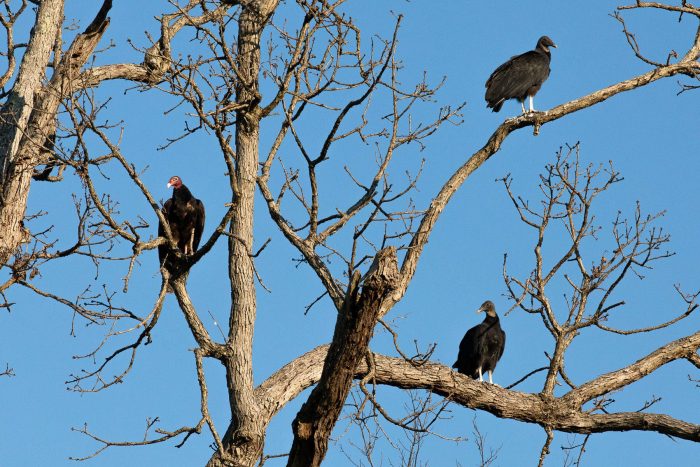Turkey Vulture
Cathartes aura
Turkey vultures are large scavengers that are commonly seen soaring above roads as they look for carrion.
This section shows one large critter image at a time. Use the thumbnails that follow to select a specific image to display here.

This gallery contains a grid of small thumbnails. Selecting a thumbnail will change the main image in the preceding section.
Appearance
Turkey vultures are large birds with an average wingspan of 65 to 70 inches. When flying, turkey vultures form a “V” by holding their wings higher than the rest of their body. Their body is mostly covered in dark brown feathers with the exception of their featherless red head and a tan band of feathers that extends from their wingtip to their body.
Feeding
Turkey vultures are scavengers that find carrion (the decaying flesh of dead animals) with their strong sense of smell. They prefer fresh meat over old meat but can eat both. They will occasionally feed on vegetable matter, insects and fish.
Predators
Turkey vultures are most vulnerable when they have first hatched. Larger birds of prey, raccoons and opossums might attack them at this stage. When threatened, turkey vultures will projectile vomit their incredibly acidic stomach contents.
Flight
Turkey vultures often wobble as they fly with their wings open. They take very few wingbeats and soar on thermal currents, which are essentially hot pockets of air that propel the bird.
Voice
Turkey vultures lack a voice box. When they make noise they hiss and grunt.
Reproduction and life cycle
Turkey vultures do not create nests. Instead, they lay their eggs on rocky surfaces and tree cavities. Turkey vultures will lay one to three eggs. Both parents will incubate the eggs. After the chicks hatch, both parents will feed them by regurgitation.
Did you know?
- Turkey vultures can detect dead animals from 8 miles away.
- Turkey vultures have such a strong sense of smell that they can help gas companies detect gas leaks. Ethyl mercaptan is added to odorless gas to alert people to a gas leak. The same compound is found in carrion so when there is a gas leak turkey vultures will be seen circling above the leak.
- The turkey vulture population is currently stable but over half of the world’s vulture species are listed as endangered. In India, medicine given to livestock led to the death of 90% of the country’s vulture population. In other parts of the world, poachers purposely poison vultures so the vultures won’t give away their location when they are harvesting animals.
- Fragmenting lead bullets continue to be a threat for vultures and raptors in the Bay watershed. Using copper bullets or proper field dressing is important for reducing lead poisoning for local birds.
- Vultures are divided into two groups, New World Vultures and Old World Vultures. The two groups of vultures are only distantly related and evolved in different parts of the world at the same time with many of the same features.
- Vultures have weak feet that are designed for standing on carcasses not for carrying prey.
- Turkey vultures urinate on their own legs. This behavior helps turkey vultures thermoregulate on hot days and their acidic urine prevents bacteria from growing on their legs after they stand on carcasses.
Sources and additional information
● National Audubon Society - Turkey Vulture
● All About Birds - Turkey Vulture
● Maryland DNR - Turkey Vulture
